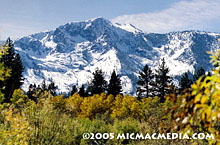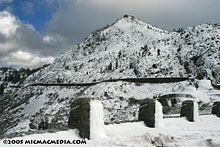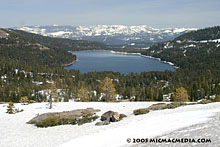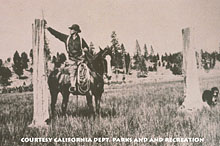|
Rare Weather Traps Donner Party
The most tragic weather event ever recorded in the Sierra Nevada occurred during the heavy winter of 1846-1847. The California-bound Donner Party did not arrive in the
Truckee Meadows, near the present Nevada-California border, until October 20, 1846. The mountains ahead were already white with the season's first snowfall. After a rest of six days the vanguard of these trail-weary
emigrants struggled up to Truckee Lake (Donner Lake), which they reached on October 31. During this push west, the second heavy snowfall of the season enveloped the higher elevations from Oct. 28-29.
October snow is not unusual in the Sierra (50 inches were recorded on Donner Pass during the second half of October 2004), but the coincidence of two
storms heavy enough to impede traffic at this early date are rare. There was a total of 10 major storm periods during the winter of 1846-47 beginning Oct. 16,
1846, and ending in early April 1847. All of them added materially to the season's remarkable accumulation, but it was the late October and early
November snowfalls that effectively shut down the trans-Sierra route and trapped the pioneers east of the Sierra crest.
The late October storm in 1846 was cold enough to cover the lower elevations with an inch or two of snow, which slowed the progress of the rear guard of settlers that
included the two Donner families. After one of the George Donner's wagons flipped over and broke an axle, they were forced to stop for repairs in Alder Creek Valley about five miles north of Donner Lake. The Donners and
their teamsters were now well behind the lead members of the wagon train who had already set up "temporary quarters" at the lake.
The October storms covered the vital Sierra pass with more than six feet of snow. Periods of rain settled the snowpack, but failed to wash it away. Two
attempts were made to cross the summit during November, but both were turned back by deep snow. In early November, a storm lasting eight days
pounded the mountains with rain and snow. When the skies finally cleared on November 13, the snow was about ten feet deep above 7,000 feet. Although fair
weather for the next two weeks melted most of the snow around Donner Lake and settled the snowpack on the summit to six feet deep, arguments and fear
stymied a breakout to safety. Another powerful storm at the very end of November dumped about five feet of snow at Donner Lake (even more on the summit), which sealed the fate for the luckless emigrants.
While the pioneers anxiously awaited the arrival of rescue teams from the Sacramento Valley, powerful storm systems continued to
pound the mountains with intervening periods of fair weather. Hard as the successive storms were to take, physically and mentally, the sunshine and thaws between the storms gave rise to false hopes that the winter was
ending.
More snow in December increased the depth at the lake to seven feet with double that amount on the summit. In mid
-December, a lull in storm activity encouraged 15 of the party to attempt a desperate crossing on homemade snowshoes. Each member of this "Forlorn
Hope" carried about a week's worth of starvation rations. It would take them 33 days to reach the first settlement, Johnson's Ranch, in the Sacramento Valley.
Only seven of the snowshoers survived their horrific ordeal of fatigue and starvation, including all five women who set out.
A series of storms ended Feb. 6 and this was followed by an extended period of
fair weather. At this point the snow at Donner Lake exceeded ten feet deep; up at Alder Creek the depth was probably somewhat less, but the pioneers there
were still snowbound. During a mid-February interlude of fair weather, two rescue parties from California succeeded in crossing the summit and reaching
the two encampments. A group of seven able-bodied men and 17 starving refugees set out to traverse the mountains on March 3. On the third day out they were blasted by a severe blizzard that lasted two days.
Most members of this group, which included all nine members of the Breen family, were too weak to go on. They built a fire and waited for help. Their
campfire melted the snowpack until they were all huddled in a pit 24 feet deep. Another rescue party found them there four days later.
More snow fell in March with the final major storm period lasting from March 28 to April 3. Louis Keseberg, the last remaining survivor,
was rescued from Donner Lake on April 20.
Pioneer Patrick Breen kept a diary from Nov. 20, 1846, until March 1, 1847. In it he gave a first-hand account of the weather at Donner
Lake and some of the daily events. It is one of the most remarkable documents of the American West. In general, Sierra snow depths fluctuate greatly during the winter
months, but on January 13, Breen wrote, "Snow higher than the shanty, must be 13 feet deep." Heavy snow fell later in the month and on Feb. 1, Breen observed
, "The snow has not settled much." From Feb. 4 - 6 Breen says about six more feet of snow fell. The peak snow depth was probably somewhere between 15 to 20 feet deep at Donner Lake.
Stumps of trees cut by the emigrants ranged from 15 to 18 feet in height, indicative of the exceptional snowpack that winter. Snow depths at the Alder
Creek location were less due to its distance from the spillover zone of the snow-generating Sierra range. Cut trees at Alder Creek indicate a snowdepth there of approximately 10 to 12 feet.
KEY POINTS:
- Powerful winter storms in October and early November 1846 covered the Sierra Nevada with about 10 feet of snow and trapped the Donner Party
wagon train east of the pass.
- Ten major storm periods generated exceptionally deep snowpacks at Alder Creek (10-12 feet), Donner Lake (15 to 20 feet) and on Donner
Pass (25 feet & more).
- Rain and snow pounded the mountains from Nov. 1 to Nov. 11, which buried the pass to California with 10 feet of snow.
- Indicative of very cold air masses that originated in the Gulf of Alaska, on January 19 ice and frost formed in San Francisco and on March 10 snow
fell in Monterey, a very unusual occurrence.
- Stumps of trees cut by the emigrants ranged from 15 to 18 feet in height (according to some sources, one stump near the lake was measured at
22 feet, 6 inches), and represent important physical evidence of that winter's deep snowpack
|





